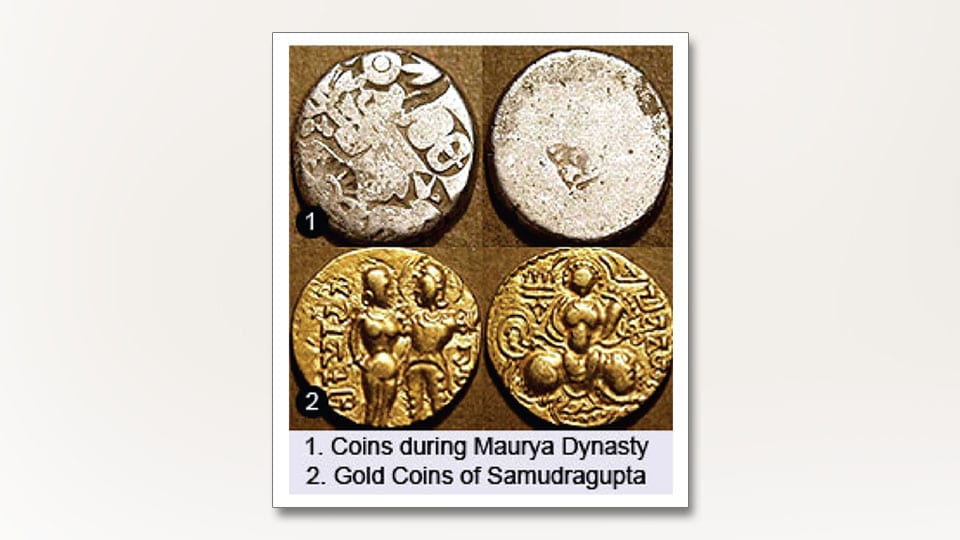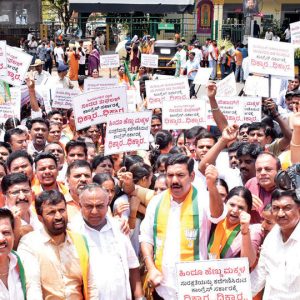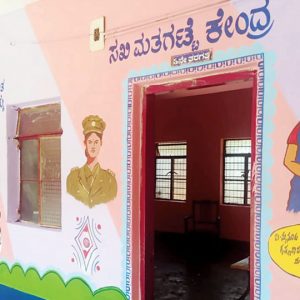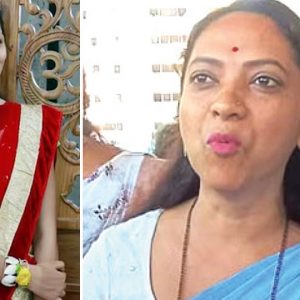By Prof. A.V. Narasimha Murthy, former Head, Department of Ancient History & Archaeology, University of Mysore
South India, comprising Karnataka, Andhra, Tamil Nadu and Kerala, has a distinctive system of coinage from ancient times which continued till recently when the Britishers introduced almost a common system of coinage for the entire country with some exceptions of kingdoms ruled by Maharajas or Sultans like those of Mysore, Hyderabad, etc. Varieties of coins look like cumbersome today, but it has to be remembered that it worked fairly well. Another unique feature is the continuity of coinage from its inception.
The earliest coins are called punch-marked coins because five or six punches were made on them and each punch represented a particular entity. In fact these coins have been taken to be of the Mauryan rulers including Ashoka. In South India punch-marked coins are the earliest. It is noteworthy that a silver punch-marked coin was found at Banavasi in Karnataka, and this is perhaps the earliest coin of Karnataka. Similar coins have come from Tamil Nadu also. Thus these coins were in circulation in South India till the Pallava coins came into vogue. In this connection I should hasten to add that Sangam age is a highly accomplished culture in Tamil Nadu and Sangam age coins have been discovered in many places there. This brings great antiquity to the South Indian coinage perhaps to the first or second century AD.
Trade between Rome and South India
In the meantime, there was an active trade between Rome and South India in the early centuries of the Christian era and it continued till 6th century AD of the Byzantine empire. South India was rich in spices which were in great demand. Particularly black pepper was in great demand as it was considered an antidote for Malaria. Roman merchants came to South India and purchased spices and semi-precious stones by paying Roman gold and silver coins and this made great impact on South India. This trade activity was at its peak during the rule of Roman emperors Augustus and Tiberius from 23BC onwards. The HAL Airport (Bengaluru) premises has yielded many Roman silver coins.
In Karnataka, gold coins known as Padmatankas have been found and they are ascribed to the Kadambas of Banavasi. They are made of gold. In fact they are the earliest gold coins found in Karnataka. Vishnukundin kings continued this tradition in Andhra. In the meantime, Satavahanas minted coins pre-dominantly in lead and these coins have been synonymous with the early period of Andhra and Karnataka. About 20 places in Karnataka and 15 places in Andhra have yielded varieties of Satavahana coins.
Minting coins
Imperial Cholas of TN — Rajaraja and Rajendra (985 – 1016AD and 1012 – 1044) expanded the Chola kingdom and in keeping with their status minted coins in gold, silver and copper.
The Kalyana Chalukyas minted punch type coins and each punch had a letter which read together gave the name of the king. The Hoysalas famous for temples in Belur, Halebid and Somanathapura also minted coins in gold, silver and copper. Vishnuvardhana the greatest ruler of the dynasty minted coins with lion on the obverse and his titles such as Talakadugonda (Conqueror of Talakad) and Nolambavadigonda (Conqueror of Nolambavadi). One unique coin of this dynasty contains the portrait of Sri Ramanujacharya with the writing Sripattana which is near Tonnur and Melkote where Ramanujacharya stayed for sometime after his flight from TN. The Yadavas of Devagiri also minted coins with lion motif and the name of the ruling king in Nagari.
The Yadava coins contain a lion on one side and the name of the king on the other. The Kadambas of Goa and Hanagal though considered as minor dynasties, minted coins in great variety which made a deep impact on the contemporary political scene.
With the establishment of the Vijayanagara empire golden period is seen in South India. This empire practically encompassed the whole of South India. This period is really the golden age of South Indian coinage. Almost all the kings of this dynasty minted coins in all metals but gold coins predominate during the period. Another unique feature is the predominance of Kannada writing on Vijayanagar coins which perhaps shows their love of Kannada or Karnataka. Among these the gold coins of Krishnadevaraya occupy a unique place.
Devotion to Tirumala
This emperor was a great devotee of Venkatesvara of Tirupati and paid a visit to this temple after every success in a war. Hence to show his devotion to God of Tirumala, he minted gold coins with the portrait of Lord Venkatesvara in addition to Balakrishna type, Narasimha type and Garuda type.
Achutaraya minted gold coins with the emblem of Gandabherunda, which became popular later. Sadashivaraya of the same dynasty minted coins with the portrait of Siva and Parvathi, with Nagari and Kannada legends. Venkatapatiraya II also minted Tirupati Venkateshwara type coins.
The next ruler issued coins with the portrait of God Venkatesvara with Sridevi and Bhudevi. The Vijayanagara coins made a great impact on the future coinage. The Keladi Nayakas also minted coins which are imitations of the Vijayanagara coinage. In the medieval times this area was ruled by Bahmanis, Adil Shahis and Barid Shahi dynasties. They minted coins with legends in Persian on both sides. Some of them are very elegant. In the same tradition Hyder and Tipu minted coins. Actually Tipu had 17 mints in his short rule. Usually his coins contain elephant on the obverse and Persian writing on the reverse.
Finally, Mysore Wadiyars minted coins in all the three metals. Ranadhira Kantirava Narasaraja Wadiyar was the first to establish a mint. Krishnaraja Wadiyar III minted a variety of coins which are very elegant. Their coins usually contain the legend Chamundi with the portraits of elephant or lion.
With the abolition of monarchy, Mysore Wadiyar coins came to an end. The British introduced their own coinage which also was stopped with India getting independence.








Recent Comments